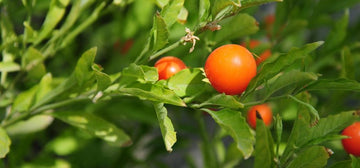
Ashwagandha – scientifically known as Withania somnifera – is described in Ayurvedic medicine as a powerful rejuvenating herb, adding to life longevity. It has been used in India, the Middle East, and someparts of North Africa for more than two millennia.
Ashwa means horse in Sanskrit, and gandha means smell. This can be taken literally because the secondary aroma of Ashwagandha is very similar to the smell of a horse. But on a deeper level, the word gandha means character, or essence—the smell of something can be thought of as the intrinsic character of that thing. Ashwagandha gives you the character of a horse in many ways.
Horses can adapt to increasing levels of stress. Racehorses are trained to run faster and faster. The reason people use racehorses instead of other animals in various performance products is because that horses can cope with this constant increase of stress. As horses can handle a great load of stress, ashwagandha helps you to gain the same ability; it gives you the stamina of a horse—physically, mentally, and sexually. It helps you win the races that life gives you. These are the properties of the herb, and you can see that they fit nicely with the meaning of the Sanskrit name, ashwagandha.
Ashwagandha is first described in sacred Ayurvedic texts.the Charaka and the Sushruta Samhitas.
Ashwagandha is described as a Balya, which promotes strength and vitality, according to Charaka Samhita. Other Ayurvedic texts categorized Ashwagandha as Breehana enhancing muscle bulk, and Vajikarna as promoting sexual wellness and acting as an aphrodisiac. Traditionally, Ashwagandha is categorized as a Rasayana, according to Sushruta Samhita, which can slow the process of aging, boost longevity and enhance mental and physical strength.
Ashwagandha the queen of Ayurveda has become famous outside of India after Korean ginseng became popular some years ago. Ashwagandha has similar adaptogenic properties as ginseng. It helps you deal with the elevated pressure of more and more stress in life.
Which part of the plant can be used?
Every single part of the shrub is immensely beneficial in some way or the other. The bitter leaves of Ashwagandha are known to reduce fever and swelling, and the flowers work as an astringent, detoxifier, diuretic, and aphrodisiac. The seeds have antihelminthic properties and are used for treating and preventing infectious diseases and parasitic invasions. The fruits may be used as a topical treatment for tumors and tubercular glands, carbuncles, and skin ulcers. Historically, the roots of Ashwagandha are the most crucial part of the plant and are widely used in various formulations.
The root has potent aphrodisiac, diuretic, anti-helminthic, anti-oxidant, anti-depressant, anti-diabetic properties and has been used to maintain youthful vigor, stamina, strength, and health in individuals.
What are the Health Benefits of Ashwagandha?
Many people relate ashwagandha with just boosting sexual performance but get ready to blow your mind because Ashwagandha has an impressively wide range of therapeutic effects.
Look at the inexhaustive list of benefits of Ashwagandha one by one:
Stress and Anxiety
Bodyweight management
Memory and cognition
Muscle strength
Cardiorespiratory endurance
Sleep
Anti-aging and Longevity
Immunity
Inflammation
Blood Sugar
Cancer
Ashwagandha is an ancient medicinal herb with a myriad of health benefits. As a potent contributor to healing and wellness, the adaptogenic effect of Ashwagandha combined with the whole body approach promotes an overall feeling of wellbeing.




